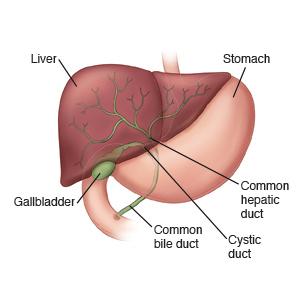Your belly (abdominal) pain may be due to inflammation and a possible infection in the gallbladder. This is called cholecystitis. The gallbladder is a small sac under the liver. It stores and releases bile. Bile is a fluid made in the liver that helps you digest fat. When you eat fatty, greasy, or spicy foods, the gallbladder squeezes to release bile. Gallstones may form in this sac. This is called cholelithiasis. Most people don't have symptoms. Such gallstones are called silent gallstone. Since they don't interfere with the work of your gallbladder, liver, or pancreas, they don't need treatment. But if a stone moves and blocks the bile duct, it can cause pain and an infection. The infection is called cholecystitis. Bile sludge without a stone can also cause cholecystitis.
To help be sure of the diagnosis, you may need to have an ultrasound, CT scan, or other special test.
Things that increase the risk of developing gallstones include:
-
Being a woman.
-
Being obese.
-
Being older.
-
Losing or gaining weight quickly, such as from weight-loss surgery.
-
Having a high-calorie diet.
-
Being pregnant.
-
Using hormone therapy.
-
Having diabetes.
-
Having a condition that causes the breakdown of blood cells. An example is sickle cell disease.
The most common symptoms are:
-
Pain, cramping, or aching in the belly.
-
Upset stomach (nausea).
-
Vomiting.
-
Fever, including a mild fever or chills.
Other symptoms include:
-
Clay-colored stools.
-
Tea-colored urine.
-
Yellowing of skin and whites of the eyes (jaundice).
Many illnesses can cause these symptoms. Gallbladder pain is called biliary colic. It often starts in the upper right side of your belly. The pain can also be in the top middle part of the belly. It can spread to your right shoulder, back, and arm. It often starts suddenly, gets stronger quickly, and then slowly decreases and goes away over a couple of hours. Often, the symptoms occur in the evening or at night. Older adults and people with diabetes may have trouble showing exactly where the pain is. The pain may occur after meals, especially after eating fatty foods.
Home care
-
Short periods of gallbladder pain that go away are called biliary colic. You may rest in bed at home and follow a clear liquid diet until your symptoms go away. Call your health care provider for a follow-up appointment.
-
Your provider may prescribe antibiotics and other medicine. Take them exactly as directed.
-
If you were not given a different pain medicine, you can take acetaminophen or ibuprofen for pain. Talk with your provider before taking them if you:
-
Have chronic liver or kidney disease.
-
Ever had a stomach ulcer or GI (gastrointestinal) bleeding.
-
Are taking blood-thinner medicines.
-
-
Don't have any fat in your diet over the next 2 days. Follow a low-fat and low-spice diet after that. Fat in your diet makes the gallbladder contract and may cause more pain. If you are overweight, a low-fat diet will help you lose weight.
-
Talk with your health care provider before:
-
Changing your diet plan. Very low-calorie diets can lead to rapid weight loss and raise your risk of gallstones. Talk with a registered dietician to create a personal eating plan.
-
Starting to take any dietary or herbal supplement. They may damage your liver and interfere with your ongoing medicines. They may also cause serious side effects.
-
Call 911
Call
-
You have ongoing symptoms that don't get better.
-
You have a fever with your symptoms.
This may be due to acute cholecystitis. You should not treat this condition at home. Go to the emergency room. Often surgery to remove the gallbladder (cholecystectomy) is needed.
Follow-up care
An infection in the gallbladder is a serious problem and must be watched carefully.
-
Keep all appointments to have further testing and to see a general surgeon.
-
See your health care provider for another exam in the next 1 to 2 days, or as directed.
Once cholecystitis has occurred, removing the gallbladder may be needed to keep it from happening again. You can talk with your provider about this at your follow-up visit. If you are hospitalized for cholecystitis, your gallbladder may be taken out during that same hospital stay. Gallstones that aren't causing infection or symptoms often don't need surgery.
When to get medical advice
Contact your health care provider if you have:
-
Repeated vomiting.
-
Belly swelling.
-
Pain lasting more than 6 hours.
-
A fever of 100.4°F (38ºC) or higher, or as advised by your provider.
-
Shaking chills.
-
Weakness, dizziness, or fainting.
-
Dark yellow pee (urine) or poop (stool) that's light gray or clay-colored.
-
Yellow skin or eyes (jaundice).
-
Chest, arm, back, neck, or jaw pain.


